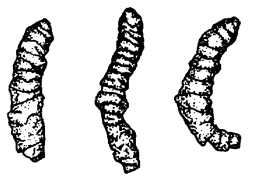 |
Science Frontiers ONLINE No. 88: Jul-Aug 1993 |
|
|
Early Life Surprisingly Diverse
The three life forms sketched below are tiny microorganisms, not the worms they appear to be. They are thought to be bacteria, for they closely resemble modern cyanobacteria. What is most important about these fossilized micro-organisms is that they were found in the Apex chert of Western Australia. The Apex chert is designated Early Archean and assigned an age of 3.465 billion years [Four significant figures!]. It is rare to find any fossils at all in rocks this old, but apparently the Apex chert escaped most of the fossil-destroying metamorphism afflicting most Precambrian formations. Even more remarkable is the diversity of these suspected bacteria. J.W. Schopf reports finding no less than eleven different kinds so far--and our planet was only a few hundred million years old at the time the Apex chert was formed.
 |
- How could life have originated and diversified to such an extent in just a few hundred millions years?
- Why after such rapid diversification did these microorganisms remain essentially unchanged for the next 3.465 billion years? Such stasis, common in biology, is puzzling.
- If these microorganisms are really cyanobacteria, they would have released oxygen to the atmosphere. Is the standard assumption that the earth's atmosphere lacked oxygen until 2.2 billion years ago correct?